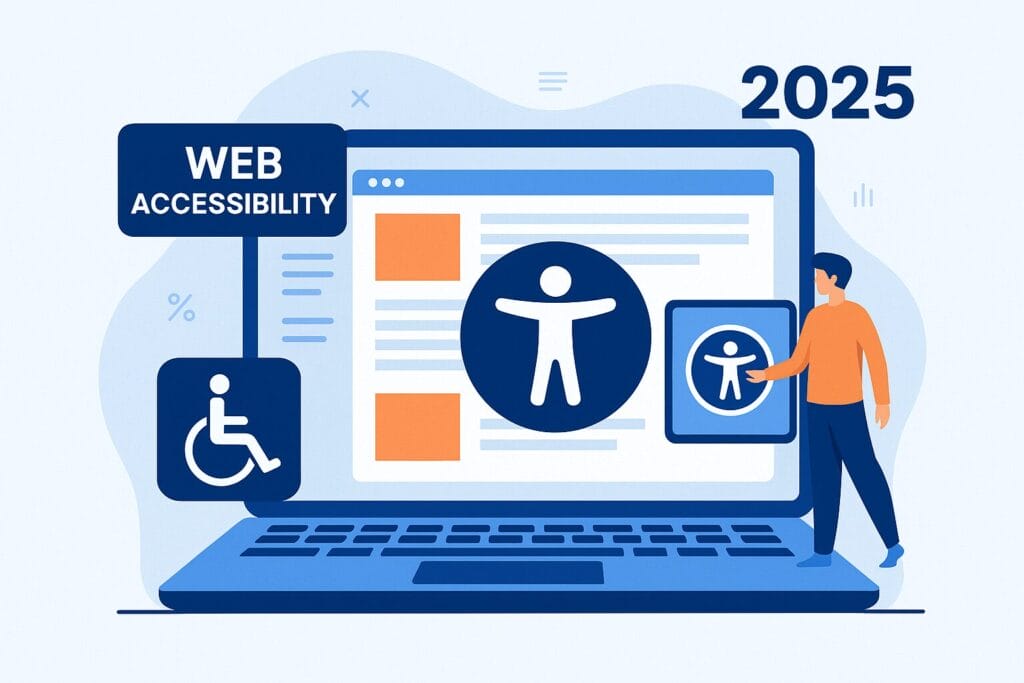Welcome All Visitors: Why Web Accessibility Matters in 2025
Imagine browsing a website with sound on while all images have no descriptions – or trying to navigate using only your keyboard. Frustrating, right? In 2025, making your site accessible isn’t just the right thing to do; it’s smart business. Over 4,000 ADA lawsuits were filed in 2024 alone over inaccessible websites, and the new European Accessibility Act (EAA) kicks in by June 2025. On the upside, accessible sites tend to attract more visitors: a recent study found they enjoyed a 12% average traffic boost. In short, opening your site’s door to everyone (including people with disabilities) can improve SEO, user experience, and even your bottom line.

Why Accessibility Matters in 2025
Legal Compliance & Risk: Regulators worldwide are cracking down. In the US, ADA-related lawsuits hit record highs, and in the EU the EAA will soon require accessible design for companies serving Europeans. Non-compliant sites face fines (or worse), so staying on the right side of the law is more than a suggestion.
Business Growth & SEO: One billion people (about 15% of us) have some disability. By making your site accessible, you tap into a huge audience. Plus, search engines favor accessible pages because they’re easier to crawl and understand. In fact, sites that follow accessibility best practices saw an average 12% spike in traffic. That means more visitors and potential customers.
Better User Experience: Good accessibility often just means good UX for everyone. Clear headings, descriptive alt text, and keyboard-friendly layouts help all users (not just those with disabilities) find what they need quickly. Happy visitors stick around longer.
Brand Reputation: Demonstrating inclusivity strengthens your reputation. Customers appreciate it when a brand “cares about everyone,” and you avoid bad press (or even lawsuits) from leaving any group out. In 2025, an inclusive site sends a powerful message of trust and social responsibility.
Quick Accessibility Wins
Ready to make your site more inclusive? Start with the basics:
Use Semantic HTML & Alt Text: Make sure images have meaningful
altattributes and that your content uses proper headings (<h1>, <h2>, ...). Screen readers rely on this structure.Keyboard Navigation: Ensure all features can be used with a keyboard (no mouse required). That means visible focus styles and logical tab order so someone using TAB/ENTER can do everything.
Color Contrast & Font: Check your color choices. WCAG 2.2 (the latest accessibility guidelines) recommends high contrast so text is legible for low-vision users. Also use readable font sizes and allow text resizing.
Captions & Transcripts: Any video or audio on your site should have captions or transcripts. This helps not only deaf or hard-of-hearing users, but also everyone who watches with the sound off (or with visual aids).
ARIA Landmarks (when needed): For dynamic content or custom components, use ARIA roles/labels so assistive tech knows what’s what. Tools like Chrome’s Lighthouse or the WAVE plugin can flag missing ARIA tags and contrast issues.
Following WCAG 2.2 (finalized in late 2023) is a great roadmap. Start small (focus on one page or component at a time), and treat accessibility as part of your design workflow. The key is to build inclusivity in, not bolt it on later.
Privacy & Tracking in 2025
While we’re caring about users, privacy is huge too. Big changes are here:
Bye-Bye 3rd-Party Cookies: Google phased out third-party cookies by end of 2024. This means you can’t rely on old tracking tricks. In 2025, focus on first-party data (info users give you directly) and transparent consent management.
Consent & Transparency: Make your privacy policy clear and get explicit consent before tracking personal data. Users trust sites that are upfront about data use. In practice, use a cookie consent banner that lets people opt in/out easily, and explain why each piece of data is collected.
HTTPS Everywhere: Secure sites (HTTPS) are a must. They protect user data and are a ranking signal for SEO. Google now flags non-HTTPS sites as “Not secure,” so grab an SSL certificate and enable it by default.
Privacy-Safe Analytics: Consider analytics tools that don’t invade user privacy (e.g. anonymized metrics). Showing users respect for privacy builds goodwill and avoids regulatory headaches.
By respecting privacy, you build trust and avoid fines under laws like GDPR/CPRA that only get tighter. And remember: an accessible site that respects privacy is doubly appealing to users.
Making It Engaging: Animations & Interactions
Accessibility doesn’t mean boring. Thoughtful animations and micro-interactions can delight users if done right:
Micro-Animations: Subtle effects (button hover highlights, gentle loading spinners, or satisfying toggles) guide users’ eyes and give feedback. As UX expert Chris Watson notes, tiny animations “give interfaces that extra bit of polish”.
Cursor & Scroll Effects: Custom cursors or scroll-triggered reveals (things that fade or slide in as you scroll) can make your site feel alive. Just test them on real users. They should enhance content, not distract from it.
Accessibility Tip: Always respect prefers-reduced-motion settings. Some users get dizzy from motion-heavy sites. Provide a “reduce motion” mode or keep effects minimal. This way, everyone can enjoy your site.
These interactive touches keep users engaged and convey quality. And fun fact: sites that are usable (accessible) often see better SEO results – search engines love happy users (low bounce rates, long visits).
For a quick taste of modern web trends, here’s a relevant video on 6 SEO and design trends that are reshaping the landscape in 2025:
Web Design And SEO: Principles & Common Mistakes (2025 Guide) – By Elegant Themes
In a Nutshell
Accessibility, privacy, speed – these are all part of a modern, user-first website. In 2025, users expect sites that load fast, feel human, protect privacy, and work for everybody. By building inclusively, you not only avoid legal risk, but you also attract more visitors, boost engagement, and strengthen your brand. Think of accessibility as simply “good design for all.” Your site (and your audience) will thank you for it.
What’s your experience with web accessibility? Share your thoughts below!